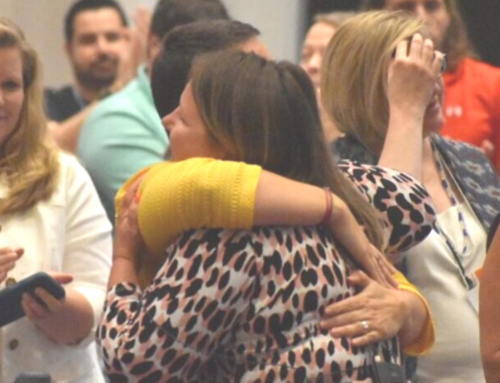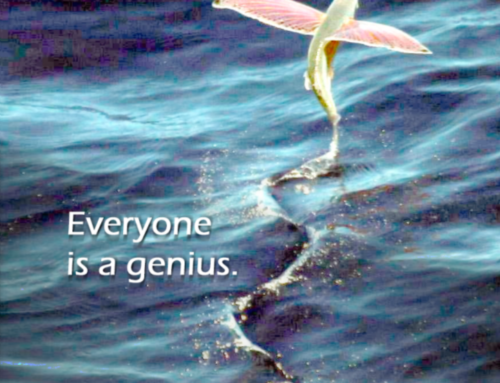Victoria Schiffer is an experienced Agile Coach with a passion for people and coaching. Her belief and inspiration from empowering great teams motivated her to deepen her strengths with a Professional Life Coaching Certificate.
Let me begin with the story about two frogs.

(Photo: “Two yellow frogs” | by Tambako the Jaguar)
There is a story about two frogs. One was hopping along at the bottom of a deep rut made by a tractor.
The other frog saw him there and said, ‘Hey! What are you doing down there? It’s much better up here; there is more food.’ The first frog looked up: ‘I can’t get out.’
‘Let me help you,’ said the second frog. ‘No. Leave me alone. I’m OK. There is plenty of food down here.’ ‘OK,’ said the second frog. ‘But there is much more space up here to explore and move around.’ ‘I’ve got all the space I need down here.’ ‘But what about meeting other frogs?’ ‘They come down here sometimes, otherwise I can shout to my friends up there.’ The second frog heaved the frog equivalent of a sigh and hopped on. The next day, he was surprised to see the first frog hopping up beside him. ‘Hey! I thought you were staying down in the rut. What happened?’ ‘There was a truck coming.’
Andrea Lages and Joseph O’Connor share this story and conclude: “For some people it takes the equivalent of a truck to move them. Other people may be reasonably satisfied and successful, but believe that ‘you do not have to be sick to get better.’ […] They want to be the best they can be, and they want their best to get get better all the time.” [1]
Who would be the frog in the rut in Agile? The Scrum Master? The Managers? The Agile Coaches? The Iteration Managers? The Product Owners? The Developers? The Business Analysts? The QA Specialists? I’d like to throw in the hypothesis that each one of us Agilists, no matter which role, at times is like the frog in the rut.
We’re great in seeing the big picture as well as seeing what’s going on for our teams. We do this through regular Retrospectives. They enable us to become more aware of the things happening for us to take action on them and improve. In this regard, we don’t wait for the tractor to come. And what about the things we don’t even see?
“We think too small, like the frog at the bottom of the well. He thinks the sky is only as big as the top of the well. If he surfaced, he would have an entirely different view.” (Mao Zedong)
Filters & Perspectives
For us the well are our internal filters, that prevent us from going crazy if we were to consciously perceive everything of the things going on around us. A good example are parents to be. Suddenly they see prams everywhere. “They weren’t here before, where did they suddenly come from?”. Of course they were there before, at that time they just weren’t relevant to them.

(Photo: “Stroller Parking” | by Kevin Poh)
Similarly this can be applied to our workplace. For example let’s take the discussions we have: be it in one-on-ones, in a decision-making process, in retrospectives, in “normal” meetings or elsewhere. Every single one of us only hears the things that pass our own internal filters. And these are based on our beliefs, values, memories and experiences. As Irving Berlin states it “Life is 10% How You Make It and 90% How you Take It“.
A typical example in the workplace is “us vs. them”, seeing a problem and having the other team fix it, as it is “their” problem. Day in day out we will perceive the things that go with “us vs. them”, we will have our internal filters make sure this is true for us. If we had the attitude that it is “our” problem, we would approach the situation in a whole new way. The saying “What the thinker thinks, the prover proves” states this very well. See the 140 seconds video on it below.
The good news is: We have a choice to change our beliefs, to change our attitude. They are not cast in stone! So let’s start to change our 90% how we take it!
Seeing things as you want to see them
So the key is making sure we see the things we want to see to be able to further improve ourselves, improve our teams, improve our companies, to become better Agile Coaches. And how do we do this?
In Life Coaching there are many great concepts that help to consciously shape the 90% how we take it. Each of which could very well be another blog post itself. So I’m just going to briefly introduce a couple.
Listening
“Most people do not listen with the intent to understand; they listen with the intent to reply.” (Stephen R. Covey, The 7 Habits of Highly Effective People).
Our mind tends to only take a couple of seconds to agree, disagree or match the things being heard against our own experiences. And then we jump in to discuss. And do we really listen to understand? What can you do to make sure? Have some courage for silence! This is not as easy as it sounds, but it’s well worth it!
Experiment #1: Next time you talk to someone, try to fight your inner drive to jump in with your story, with your agreement. If the other person stops talking, mentally count to 3. Often people continue their story if given the time for their thoughts. Experiment #2: Even if someone stops, also after having counted to 3, instead of jumping in with your part of the story, ask a question for more clarification and see what happens.
Questioning

(Photo: “Question Mark Cookies 2” | by Scott McLeod)
In Life Coaching we believe people have all the answers, they just might not have the right questions at the time. Here’s where powerful questions come in handy. Use “What”, “How”, “When” questions. Try to avoid “Why” questions, as this leads people to go into defence mode. A better approach is to use “What did this get for you?”. Ask with curiosity and avoid judgement (even if not intended). Questions asked with a tone of curiosity create trust and the willingness to give more insights. Incisive questions are very powerful, as they expand our limiting view on things. Use questions like “What if you could…”, “What if you had all the time in the world?”, “What if you failed…?”, “What if you succeeded…?” or even laser questions like “What stops you?”. These open up our thinking, a very powerful tool for retrospectives, or decision-making processes.
Experiment #3: Whenever you find yourself using a “why” question, stop yourself and rephrase it as a “What does this get for you?” question. Experiment #4: Next time you hear someone say “We can’t do this.”, ask an incisive question (e.g. “What if you could?”). Experiment #5: In your retro, throw in some incisive questions, e.g. “What would you do if X was unlimited?”
NLP Presuppositions
The Meaning of Your Communication is the response you get

(Photo: “Conversation” | by Jim Pennucci)
NLP Presuppositions are powerful assumptions that help us influence our beliefs. These shape the things we consciously perceive.
“Your beliefs become your thoughts, Your thoughts become your words, Your words become your actions, Your actions become your habits, Your habits become your values, Your values become your destiny.” (Mahatma Gandhi)
Some of the following NLP Presuppositions might be already well known to you, others might be new to you.
“The Meaning of Your Communication is the response you get” – Just because we said it in the best way possible, doesn’t mean the message is received in the way intended. And it also doesn’t mean our discussion partner just doesn’t get it. It’s our responsibility to communicate better, so that our message is received correctly.
“Anything can be accomplished when the task is taken in small enough chunks.” – At the core of of Agile and Lean. Break things in smaller pieces and iterate over them. Learn and continue to build the right things right.
“I didn’t fail the test, I just found 100 ways to do it wrong.” (Benjamin Franklin)
“Failure is only Feedback” – We embrace “fail fast” in Agile. Lean Product Development follows the build-measure-learn cycle. This presupposition brings learning through failing to a new level. It goes beyond just learning from our customers. We should apply the potential of learning through failure even for ourselves and our team mates.
There are many more NLP Presuppositions, these are just a couple, mapped to their use in Agile.
Experiment #6: Tell yourself one of the NLP presuppositions for a whole day or even a week. See how it changes your perception and thus your action.

Limiting and Empowering Beliefs
(Photo: “Can’t Fail Cafe, Emeryville” | by 305 Seahill)
Again as our beliefs shape our perceived world, being aware of the two types of beliefs: limiting and empowering can make a huge difference for ourselves. Pressure Words (should, must, have to, need to, ought to),Unconsidered Opinions (better, obviously, clearly, worse),Overgeneralizations (never, nobody, always, everybody) are limiting for an individual and team. They close the door rather than opening it for new perspectives and expanding options. However, when you hear them, you can challenge them with questions to get a clearer picture. Abstract Words (failure, stress, frustration, success) should be clarified. If we only accept them being said, we only use our own interpretation of what they mean. Yet they all have a different meaning to every single one of us. So again, ask some curiosity questions for clarification.
Beliefs (can’t, can) can be limiting (can’t) or empowering (can). Do check in on whether it’s a definite can’t or just a temporary one (at the moment). The best thing to do is to get some awareness on the limiting and empowering beliefs. Turn them into a conscious Choice (want to, don’t want to).
Experiment #7 : Listen for these words in your next meeting, one-on-one, retrospective and any other chat you have. Challenge them and in a curious way ask for more clarification.
Continuously improve yourself!
Try to get better every single day. This applies to you and your team. However, you are the starting point! Don’t beat yourself up about not being like somebody else!Remember:
“The only person you should try to be better than, is the person you were yesterday.” (Unknown)
Experiment with the aforementioned in your Agile Team and see the difference it makes for you and every single team member.
I’m curious to learn about your experiments and what you learned! Please share them with me and others in the comments. How did you apply these concepts in Agile and what were your results?
“Triumph is just a little umph added to try.” (Tim Owens)

(Photo: “Spunky triumphant” | by Don Kasak)
Originally posted on Linkedin Pulse Dec 20, 2015.







